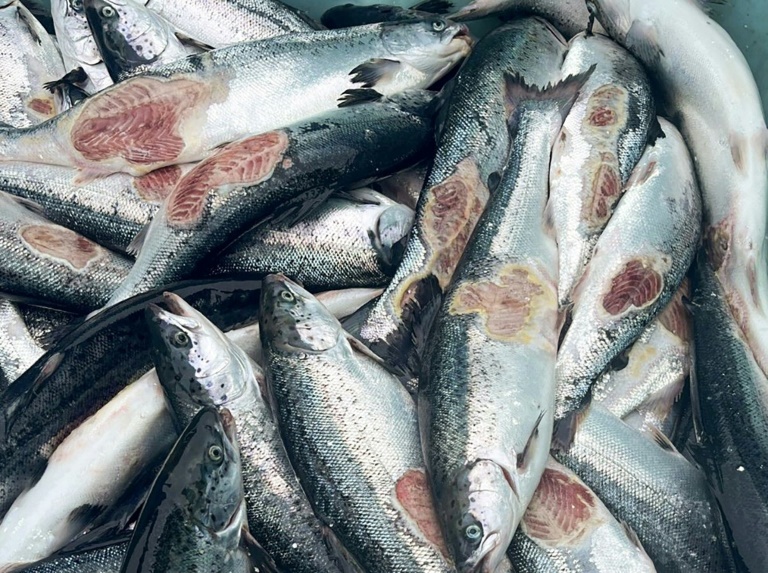Science
Pharmaceutical Pollution Threatens Atlantic Salmon Migration Success

Recent research has revealed that pharmaceutical pollution poses a significant threat to the migration success of Atlantic salmon. A study conducted by the Swedish University of Agricultural Sciences found that common pharmaceutical contaminants, particularly the medication clobazam, can positively affect the migration of juvenile salmon. This alarming finding highlights the complex relationship between human activity and environmental health.
Pharmaceutical waste, which includes substances like clobazam—a medication often prescribed for sleep disorders—remains a growing environmental concern. Wastewater treatment plants frequently release water containing pharmaceutical concentrations that far exceed levels found in standard utility plant discharges. Consequently, this situation raises critical questions about the effectiveness of current regulations designed to manage pharmaceutical waste.
The study demonstrated that the presence of clobazam in the waters of Sweden’s River Dal significantly influenced the ability of juvenile Atlantic salmon (Salmo salar) to navigate their migration routes to the Baltic Sea. Specifically, researchers noted that exposure to clobazam not only improved the fish’s success in migrating but also shortened the time required to pass through hydropower dams—typically significant barriers during their journey.
Additionally, the research examined the effects of tramadol, another common pharmaceutical contaminant. The study utilized slow-release pharmaceutical implants and animal-tracking transmitters to monitor the behavior and migration patterns of these juvenile salmon. This innovative approach allowed scientists to gain valuable insights into how these pollutants affect the natural behaviors vital for the species’ survival.
The implications of these findings are substantial. Any alteration to the natural behavior and ecology of Atlantic salmon can have cascading effects on the broader aquatic ecosystem. Although the decline of this species is mainly attributed to overfishing, habitat loss, and fragmentation, the growing impact of pharmaceutical pollution cannot be overlooked.
Dr. Marcus Michelangeli from Griffith University‘s Australian Rivers Institute emphasized the urgency of addressing this issue. He noted, “Pharmaceutical pollutants are an emerging global issue, with over 900 different substances detected in waterways worldwide. Of particular concern are psychoactive substances like antidepressants and pain medications, which can significantly interfere with wildlife brain function and behavior.”
As the environmental effects of pharmaceutical pollution become clearer, there is a pressing need for pharmaceutical companies to design drugs that degrade more rapidly or pose less risk after use. By implementing such changes, the industry can play a crucial role in mitigating the negative impacts on wildlife and ecosystems.
The findings of this research were published in the journal Science in March 2024, under the title “Pharmaceutical pollution influences river-to-sea migration in Atlantic salmon (Salmo salar).” The study serves as a critical reminder of the interconnectedness between human health, pharmaceutical practices, and environmental integrity.
Addressing the challenges posed by pharmaceutical pollution will require collaborative efforts among governments, industries, and researchers to ensure the protection of vital species like the Atlantic salmon and the ecosystems they inhabit.
-

 Lifestyle1 week ago
Lifestyle1 week agoWinnipeg Celebrates Culinary Creativity During Le Burger Week 2025
-

 Science3 weeks ago
Science3 weeks agoMicrosoft Confirms U.S. Law Overrules Canadian Data Sovereignty
-

 Education2 weeks ago
Education2 weeks agoRed River College Launches New Programs to Address Industry Needs
-

 Technology3 weeks ago
Technology3 weeks agoDragon Ball: Sparking! Zero Launching on Switch and Switch 2 This November
-

 Science3 weeks ago
Science3 weeks agoTech Innovator Amandipp Singh Transforms Hiring for Disabled
-

 Technology3 weeks ago
Technology3 weeks agoWorld of Warcraft Players Buzz Over 19-Quest Bee Challenge
-

 Technology3 weeks ago
Technology3 weeks agoGoogle Pixel 10 Pro Fold Specs Unveiled Ahead of Launch
-

 Science3 weeks ago
Science3 weeks agoChina’s Wukong Spacesuit Sets New Standard for AI in Space
-

 Science3 weeks ago
Science3 weeks agoXi Labs Innovates with New AI Operating System Set for 2025 Launch
-

 Technology3 weeks ago
Technology3 weeks agoNew IDR01 Smart Ring Offers Advanced Sports Tracking for $169
-

 Technology3 weeks ago
Technology3 weeks agoGlobal Launch of Ragnarok M: Classic Set for September 3, 2025
-

 Technology3 weeks ago
Technology3 weeks agoFuture Entertainment Launches DDoD with Gameplay Trailer Showcase
-

 Technology3 weeks ago
Technology3 weeks agoHumanoid Robots Compete in Hilarious Debut Games in Beijing
-

 Science3 weeks ago
Science3 weeks agoNew Precision Approach to Treating Depression Tailors Care to Patients
-

 Technology3 weeks ago
Technology3 weeks agoInnovative 140W GaN Travel Adapter Combines Power and Convenience
-

 Business3 weeks ago
Business3 weeks agoNew Estimates Reveal ChatGPT-5 Energy Use Could Soar
-

 Health3 weeks ago
Health3 weeks agoGiant Boba and Unique Treats Take Center Stage at Ottawa’s Newest Bubble Tea Shop
-

 Science3 weeks ago
Science3 weeks agoNew Study Reveals Surprising Impact of Gratitude on Helping Behaviors
-

 Technology3 weeks ago
Technology3 weeks agoBorderlands 4 Promises Massive Changes with 30 Billion Guns
-

 Technology3 weeks ago
Technology3 weeks agoDiscover the Relaxing Charm of Tiny Bookshop: A Cozy Gaming Escape
-

 Technology3 weeks ago
Technology3 weeks agoQuoted Tech Launches Back-to-School Discounts on PCs
-

 Lifestyle3 weeks ago
Lifestyle3 weeks agoVancouver’s Mini Mini Market Showcases Young Creatives
-

 Education2 weeks ago
Education2 weeks agoAlberta Teachers’ Strike: Potential Impacts on Students and Families
-

 Business1 week ago
Business1 week agoZellers Set to Return to Edmonton Mall in Former Hudson’s Bay Space










